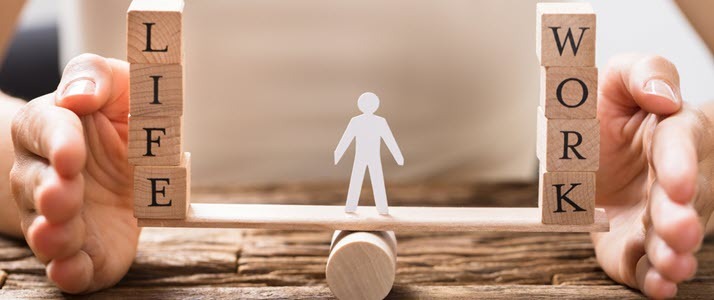Putting the Focus on Wellness and Work-Life Balance: An Interview With Leaders From ADP and Mindbody

Work-life balance — or work-life integration — is essential for the long-term health and resilience of associates. Leaders from ADP and Mindbody say that by intentionally modeling and encouraging these behaviors, leaders can create a culture of wellness, even in a remote environment.
Managing work and life has always been challenging. Now, with so many people juggling additional responsibilities, they feel even more stressed about health, financial and societal issues. That makes having a culture of wellness not just essential, but urgent.
But how can businesses focus on wellness and work-life balance, especially when working remotely? To find out, we talked with Michelle Berlin*, Senior VP People & Culture, Mindbody, and Bob Lockett, Chief Talent Officer, ADP.
Q: How can business leaders make wellness part of their organizational culture in a virtual environment?
Berlin: As leaders, we have to model the behavior we want to see. That doesn't change, whether we are in-person or virtual. Are we taking care of ourselves in all dimensions of wellness: physical, mental, emotional,and financial? What words do we use and how do we behave that reflects our focus? How do we listen to people and check in with them, especially now? When working at home, it's so easy to feel always on. We have to be clear on expectations, such as what are the priorities and being firm that there should be a start and end to the workday.
Lockett: We should also make sure team members know about the Employee Assistance Program, webinars, resources and any other benefits that are available. All of the areas of wellness that Michelle mentioned are interrelated. For example, financial challenges that come from a lack of planning can cause mental stress. We have to look at the whole person when we think about wellness.
Q: With all the various stresses people are going through, how should employers establish work-life balance for their workforce?
Lockett: As leaders, we have to understand that our associates face different situations and need support tailored to their challenges. After the initial crisis, it is critical to help associates stabilize, especially when they get anxious over uncertainty. We need to be optimistic and help associates envision the next phase of coming out of the crisis and how re-entry into the workplace will look.
Berlin: We need to have a communication strategy and plan for this new work environment. From monthly manager updates, weekly manager conversations with their team members, and other meetings, we need to make sure our people feel included in what is going on. At the same time, we also need to hear from team members. We've done several surveys to find out if they feel supported or engaged and whether they were getting the resources they needed.
It's critical to look at different ways for everyone to connect, whether that's using a tool like Slack, connecting with affinity groups or making time for team meetings that are fun and engaging. Make space for people to communicate beyond the company channel. At Mindbody, for example, we have a channel for volunteers. We have one for pet owners. These provide different ways for employees to connect.
Q: Many business owners, especially small business owners, are feeling extra stress as a result of the pandemic. What strategies can they employ to make sure they take care of themselves, too? What do you do personally that is helpful?
Berlin: We have to be mindful of going to and leaving work. I try to feel like I'm entering a workspace, even if that space was a guest room. I have my tea, water, and snack when I arrive in the room. At the end of the workday, it is important to shut down, log off and walk away. I also try to exercise every day.
Lockett: It's critically important to have a routine, regardless of your environment. I set boundaries for when I'm going to be offline. I have commitments outside of work. I coach my son's football team. Even during the day, after three or four hours, I need to take breaks. I get Zoom fatigue and have to come back to a task later that evening.
Q: With everything that has happened this year, what is coming up next for wellness in the workplace? How should we be approaching work-life balance differently than we have been?
Lockett: Instead of thinking about work-life balance, we should think about work-life integration. And that's something to remember even when we return to the office. We have to change the expectation that productivity is driven by the amount of effort versus by the quality of the output. We'll focus on resiliency and understand how we can help people achieve it. The organization can still help, but the onus is on the individual to take personal accountability for their progress.
Berlin: Wellness at work is a conversation we have to keep having. We've been heading down this path, but because of the pandemic, that process got accelerated. As employers and business owners, we are now intentionally looking at how to serve our people and have conversations that will lead us to those solutions.
[VIDEO] How can businesses focus on wellness and work-life balance, especially when employees are working remote? To find out, we talked with Michelle Berlin, Senior VP People & Culture, Mindbody, and Bob Lockett, Chief Diversity and Talent Officer, ADP.
Visit the Mindbody page on ADP Marketplace to learn more.
This interview was edited and condensed.
*Michelle Berlin leads the international People & Culture Team, focused on people strategies and organization effectiveness in support of Mindbody's vision. After joining Mindbody in 2016, she developed the consultative P&C Business Partner and Program Management Teams. The People & Culture Team she directs is responsible for finding the best talent for Mindbody and engaging, developing, and inspiring team members to live our core values in all aspects of their roles.



